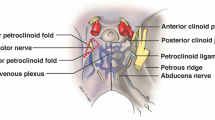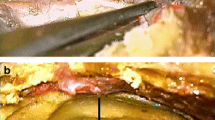Abstract
Background
The anterolateral triangle around the cavernous sinus is a surgical skull base triangle used as a neurosurgical landmark essential to skull-based surgeries. There are few reports of its measurements with little attention paid to anatomical variations.
Methodology
A total of 15 adult human cadaveric skulls were dissected to expose the anterolateral triangle on both sides. The triangle was defined and measurements of the three borders were taken precisely and the area of each triangle was calculated using Heron’s formula.
Results
On an average, the length of the anteromedial border is 11.4 (+ 2.2 mm); the length of the posteromedial border is 8.7 (+ 2.6 mm); the length of the lateral border is 13.06 (+ 2.6 mm) and the area of the anterolateral triangle is 48.05 (+ 17.5 mm2).
Conclusion
Concise understanding of anterolateral triangle is essential to skull-based surgeries; comprehending its anatomy helps with better surgical planning and provides insight into local pathology.




Similar content being viewed by others
Availability of data and materials
Data and material related to the report will be available with the corresponding author for further reference.
References
Rhoton AL (2002) The cavernous sinus, the cavernous venous plexus, and the carotid collar. Neurosurgery 51(4):S375-410
Parkinson D (1965) A surgical approach to the cavernous portion of the carotid artery. Anatomical studies and case report. J Neurosurg 23(5):474–483. https://doi.org/10.3171/jns.1965.23.5.0474
Bayatli E, Cömert A (2023) Scratching in the minefield: using intertriangles line to safely perform anterior petrosectomy. Surg Radiol Anat 45:513–522. https://doi.org/10.1007/s00276-023-03131-w
Watanabe A, Nagaseki Y, Ohkubo S, Ohhashi Y, Horikoshi T, Nishigaya K et al (2003) Anatomical variations of the ten triangles around the cavernous sinus. Clin Anat N Y N 16(1):9–14. https://doi.org/10.1002/ca.10072
Dolenc V, Rogers L (2009) Cavernous sinus: developments and future perspectives. Springer, London. ISBN 13: 9783211101636. https://www.abebooks.com/9783211721377/Cavernous-Sinus-Developments-Future-Perspectives-3211721371/plp
Chavez-Herrera VR, Campero Á, Ballesteros-Herrera D et al (2023) Microsurgical and illustrative anatomy of the cavernous sinus, middle fossa, and paraclival triangles: a straightforward, comprehensive review. SurgRadiol Anat 45:389–400. https://doi.org/10.1007/s00276-023-03105-y
Isolan GR, Krayenbühl N, de Oliveira E, Al-Mefty O (2007) Microsurgical anatomy of the cavernous sinus: measurements of the triangles in and around it. Skull base. Off J North Am Skull Base Soc Al 17(6):357–367. https://doi.org/10.1055/s-2007-985194
Granger A, Bricoune O, Rajnauth T, Kimball D, Kimball H, Tubbs RS et al (2018) Anterolateral triangle: a cadaveric study with neurosurgical significance. Cureus 10(2):e2185. https://doi.org/10.7759/cureus.2185
Kassam AB, Vescan AD, Carrau RL, Prevedello DM, Gardner P, Mintz AH et al (2008) Expanded endonasal approach: vidian canal as a landmark to the petrous internal carotid artery. J Neurosurg 108(1):177–183. https://doi.org/10.3171/JNS/2008/108/01/0177
Kassam AB, Gardner P, Snyderman C, Mintz A, Carrau R (2005) Expanded endonasal approach: fully endoscopic, completely transnasal approach to the middle third of the clivus, petrous bone, middle cranial fossa, and infratemporal fossa. Neurosurg Focus 19(1):6
Kasemsiri P, Solares CA, Carrau RL, Prosser JD, Prevedello DM, Otto BA et al (2013) Endoscopic endonasal transpterygoid approaches: anatomical landmarks for planning the surgical corridor. Laryngoscope 123(4):811–815. https://doi.org/10.1002/lary.23697
Komatsu F, Oda S, Shimoda M, Imai M, Shigematsu H, Komatsu M et al (2014) Endoscopic endonasal approach to the middle cranial fossa through the cavernous sinus triangles: anatomical considerations. Neurol Med Chir (Tokyo) 54(12):1004–1008. https://doi.org/10.2176/nmc.oa.2014-0092
Kassam A, Snyderman CH, Mintz A, Gardner P, Carrau RL (2005) Expanded endonasal approach: the rostrocaudal axis. Part .I Crista galli to the sella turcica. Neurosurg Focus 19(1):3
Dalgiç A, Boyaci S, Aksoy K (2010) Anatomical study of the cavernous sinus emphasizing operative approaches. Turk Neurosurg 20(2):186–204. https://doi.org/10.5137/1019-5149.JTN.2343-09.1
Rhoton AL (2002) The supratentorial cranial space: microsurgical anatomy and surgical approaches. Neurosurgery 51(4):S1-3. https://doi.org/10.1097/00006123-200210001-00001
Dolci RLL, Upadhyay S, Ditzel Filho LFS, Fiore ME, Buohliqah L, Lazarini PR et al (2016) Endoscopic endonasal study of the cavernous sinus and quadrangular space: anatomic relationships. Head Neck 38(1):1680–1687. https://doi.org/10.1002/hed.24301
Kawase T, van Loveren H, Keller JT, Tew JM (1996) Meningeal architecture of the cavernous sinus: clinical and surgical implications. Neurosurgery 39(3):527–534. https://doi.org/10.1097/00006123-199609000-00019. (Discussion 534–536)
Acknowledgements
We deeply appreciate the cadavers' family members who gave their loved ones' corpses for scientific study. We also want to thank the technical staff of our cadaveric laboratory for their assistance.
Funding
None.
Author information
Authors and Affiliations
Contributions
Conceptualization: AK. Data acquisition: RM, AK. Data analysis or interpretation: RM, AK. Drafting of the manuscript: RM, AK, MC. Critical revision of the manuscript: RM, AK, MC. Approval of the final version of the manuscript: all authors.
Corresponding author
Ethics declarations
Conflict of interest
Authors declare no any conflict of interest.
Consent for publication
All the authors gave consent for the publication of the report.
Ethics approval and consent to participate
This is a cadaveric study that is completely done on donated cadavers, used for teaching and research purpose. All donors or their relatives provided informed written consent prior to their death so that their bodies can be utilised for medical education and research. As the study was conducted on donated cadavers, exemption from review was taken from Institutional Ethics Committee (IEC).
Additional information
Publisher's Note
Springer Nature remains neutral with regard to jurisdictional claims in published maps and institutional affiliations.
Rights and permissions
Springer Nature or its licensor (e.g. a society or other partner) holds exclusive rights to this article under a publishing agreement with the author(s) or other rightsholder(s); author self-archiving of the accepted manuscript version of this article is solely governed by the terms of such publishing agreement and applicable law.
About this article
Cite this article
Kaliappan, A., Motwani, R. & Chandrupatla, M. Anterolateral surgical triangle of the cavernous sinus: a cadaveric study of neurosurgical importance. Surg Radiol Anat 46, 41–46 (2024). https://doi.org/10.1007/s00276-023-03261-1
Received:
Accepted:
Published:
Issue Date:
DOI: https://doi.org/10.1007/s00276-023-03261-1




